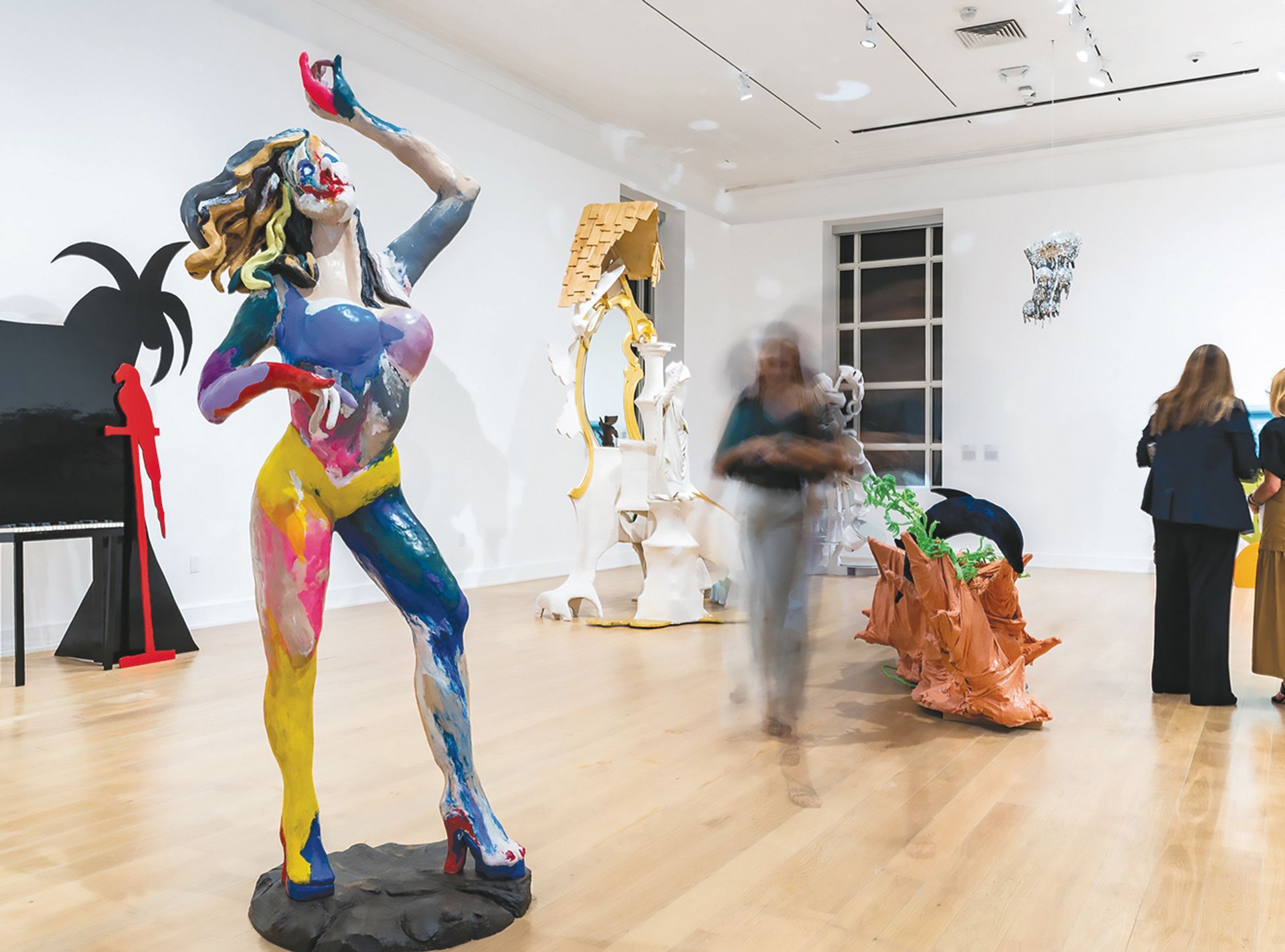Rachel Feinstein’s new exhibition at The Bass traces nearly three decades of the artist’s multifaceted career, marking her first major exhibition in her hometown of Miami. The centrepiece is the new site-specific commission, Panorama of Miami (2024), a scenographic mirrored wall panel spanning 30ft that evokes Feinstein’s memories of the city and how it has shaped and continues to influence her practice.
The Art Newspaper: How much of your practice do you feel was informed by your upbringing in Miami?
Rachel Feinstein: I believe that every artist’s life work and what they are trying to achieve from making their art stems from their childhood sights, sounds, tastes and experiences. Growing up in Miami in the 1970s and 80s was the fertile ground where all my artistic visions were born. The eccentricity, lack of culture, encroaching jungle and faux-everything had a huge impression on me as a little girl.

The centrepiece at The Bass is the mirrored wall panel Panorama of Miami (2024) Zaire Aranguren
I loved the artificiality of everything and that all the buildings had a stage or fantasy front and then a “real” back. The make-believe or fake version of France at the Epcot Center was my first inkling of what Paris would look like as a kid. Sometimes I actually prefer the Epcot version of Paris aesthetically from my child’s memory! The fake Paris more easily folds into the narcissism one has as a child. Fake Paris felt like it was something that I made up and only existed in my make-believe world, not the real-life Paris, which actually exists. Miami was more approachable as a young child than a place like Paris as it allowed me to feel in control of my own visions and destiny.
How did your practice evolve after you left, and how has Miami’s art scene changed since then?
I was intimidated by the cultural hugeness of New York City when I first arrived at Columbia University at 18 years old. I was embarrassed that I came from Miami when I would meet people from big cultural cities around the world. I had not spent any time in museums and felt shy about my art-historical knowledge because of it. But now I realise not coming from a cultural city was my gold mine. It allowed me to not feel the weight of the other great artists who came before me. I was completely unaware of them and therefore felt free to be whoever I wanted as an artist since I did not know anyone to compare myself to.
I am amazed by the transformation that has happened in Miami as a place for people to go and see art now. If you would have told me when I was ten years old that I would be a professional artist having a show of my art at a museum in Miami Beach, I would not be able to fathom it.

For Feinstein, the artificial nature of the Miami of her childhood has influenced her approach to the works included in her show at The Bass Zaire Aranguren
How did you develop your new Panorama of Miami?
When [the Bass’s chief curator] James Voorhies approached me about having a show based on my childhood and teen years in Miami, we chose works of mine that would fit that nostalgic theme. We wanted to have works that brought up the feelings of being a young person in Miami at that particularly magical time in Miami’s history. I wanted to make a new site-specific piece that would also echo that idea.
I first made a large collage of all the places from my childhood in Miami that I wanted to represent. There are places like the Serpentarium and the original Parrot Jungle that no longer exist, and places that are soon to be demolished, like my family house and the Seaquarium. I then made a large pencil drawing of the collage that I gridded up and drew out at full scale onto the mirrors and began the painting. The entire scene is on mirrors so the sky and the water are reflective and I play with washes to create reflections and clouds on the surface of the mirror. It’s a fantastical depiction of all my favourite childhood places and memories.
The show also includes another new commission, Old Cutler.
Old Cutler Road is the main thoroughfare I would use to go home to my parents’ house in Coral Gables. The road after Coco Plum Circle is so dense on each side with banyan trees that their canopy above creates a tunnel-like effect. I find myself moving down that dark, canopied tunnel as I close my eyes at night from wherever I am and realise it is the way I travel into my subconscious, much like how Hansel and Gretel walked in the dark forest and other fairytale subjects. After Hurricane Andrew [in 1992], my family returned to our house after we had to evacuate and Old Cutler had been stripped of the canopy; the nakedness was unsettling.

Feinstein’s nostalgia for old Miami haunts like the Serpentarium and Parrot Jungle is visible in her works Zaire Aranguren
What responses have you received from Miamians?
Many locals who are close to my age have told me how much nostalgia they feel from the imagery I used, especially in the Panorama of Miami. I love hearing everyone’s personal stories from their own childhoods. Using these Miami symbols from that specific magical period seems to elicit strong emotions. Even younger people have told me how many of the works in the show personify the Miami they have heard about from their parents. I’ve loved seeing visual connections to certain works that were made ten years apart or more.
• Rachel Feinstein: The Miami Years, The Bass, Miami Beach, until 17 August 2025


